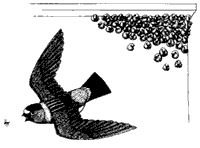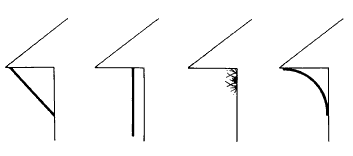|
Swallows | Swallow Overview | Swallow Damage Assessment | Swallow Damage Management | Swallow Resources | Swallow Acknowledgments | ICWDM | Wildlife Species Information |
Contents |
Damage Prevention and Control Methods

Exclusion
Exclusion refers to any control method that denies a bird physical access to a nest site. Exclusion represents a relatively permanent, long-term solution to the problem. A permit is not required for this method except when eggs or young are in the nest.
Plastic net or poultry wire can provide a physical barrier between swallows and a nest site. Mesh size should be about 3/4 inch (1.9 cm); however, 1-inch (2.5-cm) mesh has been used successfully. If plastic net is used, it should be taut to reduce flapping in the wind, which looks unsightly and results in tangles or breakage at mounting points. Do not use mist net or any other thin, flexible net with loose pockets or wrinkles that could trap or entangle swallows. For best results, install net or poultry wire before the swallows arrive. It may be left up permanently or removed after the nesting season.

Attachment methods may vary according to site requirements and the degree of permanence desired. Net can be attached using tape, staples, velcro, trash bag ties, or plastic fasteners such as zip ties or polyclips. Polyclips are a useful aid for installing netting. They snap together through the netting strands and allow the use of nails, screws, or wire for attachment. A more elaborate method uses hooks, such as brass cup hooks, mounted on wooden eaves and the sides of buildings. An advantage of hooks or velcro is that the net can be taken down easily during the nonbreeding period or for painting or maintenance of light fixtures. If hooks or staples are used, they should be rust-resistant to avoid unsightly rust stains. For net, a supporting framework of wooden dowels along the edges can ease attachment to the hooks and create a more equal tension on the net (Fig. 3). Net may also be stapled to or wrapped once or twice around wood laths, which are then nailed directly to the structure. On a concrete or cement structure, a power-activated tool, sometimes called a stud gun, can be used to nail the wood lath. The net or wire should extend from the outer edge of the eave down to the sides of the building so the eaves no longer provide swallows with protection from the elements (Figs. 3 and 4). No openings should remain where swallows might enter. Hanging a curtain of netting from eaves is reported effective (Fig. 4). The curtain should be 3 to 4 inches (8 to 10 cm) from the wall and extend down from the eave 18 inches (46 cm) or more. For barn swallows the net or wire should be extended down further than for cliff swallows to cover door and window jambs and to block off interior corners.

Usually, swallows will not fly into a net or other obstruction, but will stop and hover in front of it. If only that section of a building where swallows have nested is netted, the swallows will often choose alternative sites on the same structure. Therefore, any part of a building suitable for nesting must be netted.

Barn swallows frequently and cliff swallows occasionally enter buildings through doors or other open entryways and nest inside among the rafters. In some instances simply closing the entrance or blocking it with net or wire is practical and effective. At one site, cliff swallows abandoned nests inside barn lofts when entrance ways were partially closed. At warehouses and other buildings with frequent pedestrian or equipment passage, opening and closing an entrance way may be bothersome and impractical. In these situations strip doors of vinyl plastic may be installed (Fig. 5). Strip doors consists of 6- to 16-inch (15- to 41-cm) wide strips of vinyl hung like a curtain and are primarily used to control temperature in refrigerated areas. Strips overlap about 2 inches (5 cm). Strip doors do not require opening and closing like conventional doors and are not damaged by passage of equipment. The use of net hung as a curtain to block an entrance is recommended only where there is no possibility of its being caught and ripped by equipment. Weighting the bottom of the net will help keep it reasonably taut and in position during windy weather.
Barn swallows have been repelled from nesting by clear monofilament line attached under eaves. The lines were spaced 12 inches (30 cm) apart and were in a parallel or zigzag pattern.
Habitat Modification
- Substrate Modification.
Modification of the nest substrate has proven effective. Swallows prefer surfaces that provide a good foothold and nest attachment. Removal of the rough surface of a wall and/or overhang makes a site less attractive. This may be accomplished in various ways. Fiber-glass panels make nest attachment difficult if installed between the eave and wall to form a smooth, concave surface (Fig. 4). A smooth surface is also created by a curtain of aluminum foil or plastic tarp draped from a wire strung along the junction of the wall and roof overhang. Other smooth-surfaced materials such as glass, plexiglass, or sheet metal can be used.
A fresh coat of paint that dries to a slick surface is sometimes effective. On rough surfaces, painting is of doubtful value because it does not alter the bad-sic rough texture of the surface. Painting may be effective on smoother surfaces, but this technique has not been thoroughly tested.
Metal projections such as Nixalite® and Cat Claws® are sharp, needle-like wire devices generally installed on building ledges and window sills to discourage pigeons and starlings from roosting. Although adaptable to mounting and use under eaves, metal spines have not been widely used for swallow control (Fig. 4). In one instance, cliff swallows learned to land on the metal spines and eventually built nests attached to them.
Architectural Design. Although all the factors that constitute a suitable colony site are not yet understood or documented, architectural design does influence colony site suitability. Buildings with overhanging eaves at acute to right angles with the wall are potential nest sites. Conversely, sites where the overhang and wall meet at an obtuse angle or are rounded and concave are rarely used. The width of the overhang may be important to site suitability, although the point at which this becomes critical is unknown. Few colonies are observed with an overhang of less than 6 to 8 inches (15 to 20 cm).
Substrate texture is a factor; wood, stucco, masonry, and concrete surfaces are favorable substrates for nest attachment. Metal is rarely used as a nest substrate. Nests on metal surfaces are usually located at a crotch or joint where the swallow can gain a foot-hold. In situations where construction is planned and swallows are present on nearby structures, consideration to materials and design may eliminate future problems. Swallows may move to nearby structures if control is applied at an existing colony.
Frightening
Hawk, owl, or snake models; noise-makers; and revolving lights have shown little, if any, success or are unproven against swallows. As evidenced by nests in and on buildings, barn and cliff swallows are relatively tolerant of human activity and other disturbances.
Repellents
Chemical roost repellents (polybutenes, sticky pastes, sprays) have not been proven effective. Unless a suitable nesting site is almost entirely covered with repellent, swallows will still be able to land, gain a foothold, and begin nest construction. A sticky repellent may actually be counter-productive by improving nest adherence. Cliff swallow nests built over a sticky repellent have been observed. Since state pesticide registrations vary, check with your local Cooperative Extension office for information on possible repellents.
Toxicants, Trapping, and Shooting
No chemical toxicants are currently registered by EPA for swallow control, and shooting, trapping, or harming swallows is not permitted.
Nest Removal
Nest removal should be initiated at the first sign of nest building because of the difficulty in obtaining a permit to remove nests with eggs or young. Usually nests can be washed down with a water hose or knocked down with a pole. Removing nests by these methods is a messy and time-consuming process and may cause dispersal of nest parasites and water damage to the building.
As builders of mud nests, swallows have evolved to persist despite nest failures from rain or moisture. Washing down nests is nothing more than an artificial rainstorm. Because swallows will persistently rebuild nests, removal will be required for several days during nest building. Persistence is undoubtedly affected by the physiological condition of the swallows, past nesting history at the site, and the availability of alternate sites. The swallows may return the following year, and unless additional control measures are implemented, the whole process may need to be repeated.
Leaving swallow nests intact may be appropriate in some instances. For example, if swallows have established a colony, raised their young, and left, nest removal would also remove nest parasites, thus improving the site for the swallows returning the next spring. Swallow bugs will over winter in the nests, and if the parasite load is high in the spring, the swallows might abandon the colony. If not, they would probably reoccupy the nests. At the first signs of reoccupancy, such as repair of old nests or building of new nests, nest removal (with a permit in some locations) should be started and continued until the nesting attempts end.
|
Swallows | Swallow Overview | Swallow Damage Assessment | Swallow Damage Management | Swallow Resources | Swallow Acknowledgments | ICWDM | Wildlife Species Information |
Summary of Damage Prevention and Control Methods
Exclusion
Netting or wire mesh. Strip doors.
Habitat Modification
Substrate modification: slicker faces discourage nesting.
Architectural design: some designs discourage nesting. Avoid overhanging eaves.
Frightening
Not effective for barn or cliff swallows
Repellents
Not effective.
Toxicants
None are registered.
Trapping
Not allowed.
Shooting
Not allowed.
Nest Removal
Wash nests down with a water hose or knock down with a pole.
